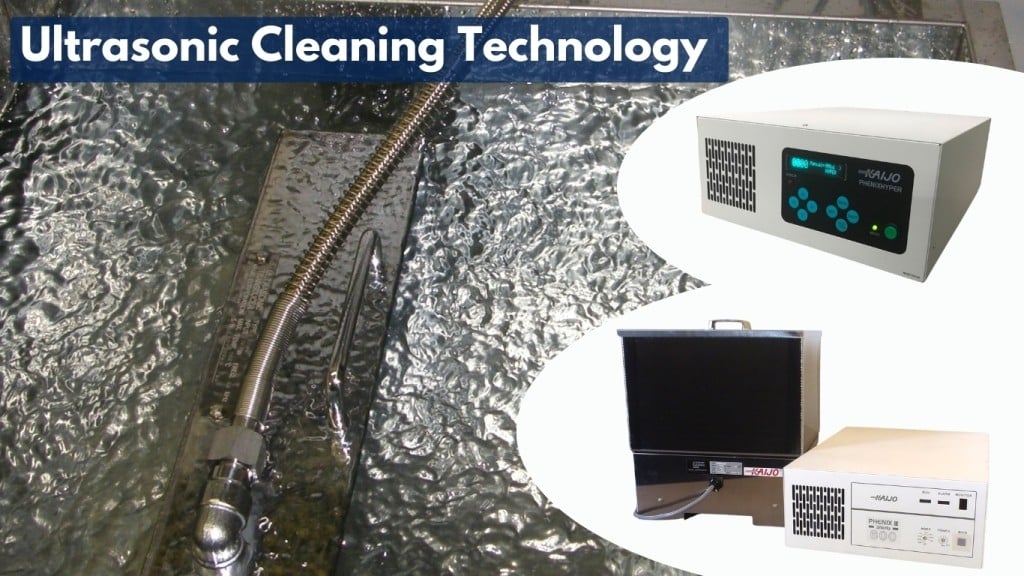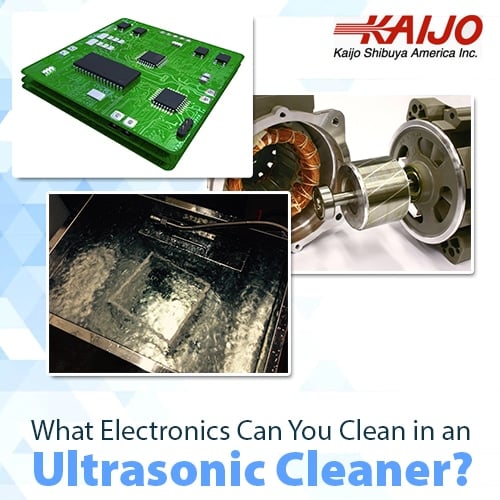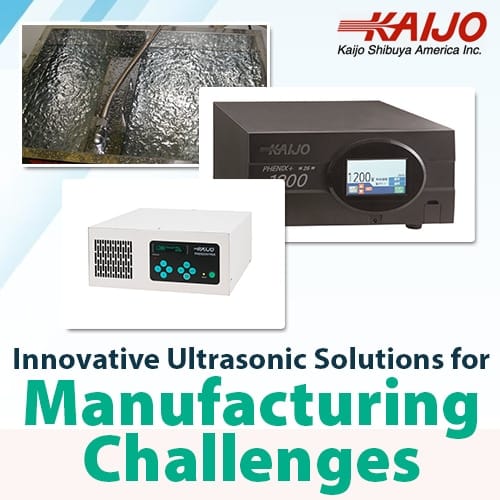Ultrasonic Cleaning Technology
Cleaner Parts. Faster Processes. Lower Costs.

Ultrasonic cleaning technology utilizes high-frequency sound waves in a liquid to remove microscopic contaminants from complex parts. Unlike traditional cleaning methods, it delivers precision cleaning in less time, with less waste, and without damaging delicate surfaces.
With advanced industrial ultrasonic cleaners, you can:
- Increase throughput with shorter cleaning cycles.
- Reduce operating costs by reducing chemicals, water, and rework.
- Maintain consistent quality across every batch.
- Meet compliance standards with safe, sustainable cleaning.
Contact Us for a Free Consultation
How Ultrasonic Cleaning Works
At the core of ultrasonic cleaning is cavitation—the rapid formation and collapse of microscopic bubbles generated by high-frequency sound waves in liquid. As these bubbles implode, they release energy that safely dislodges oils, particles, and residues, even in fine recesses or blind holes that conventional cleaning methods often miss.
Benefits in action:
- ✓ Improved Efficiency: Faster cleaning cycles reduce process time.
- ✓ Consistent Results: Uniform cavitation ensures batch-to-batch reliability
- ✓Reduced Costs: Lower chemical use reduces costs and waste.
- ✓Non-Destructive: Gentle cleaning avoids damage to sensitive surfaces.
- ✓ Operational Reliability: Easy to integrate into production environments.
Learn More About Kaijo’s Ultrasonic Cleaners
Cleaning Frequencies & Power Density
The performance of ultrasonic cleaning technology depends on selecting the proper frequency and power density for each cleaning application. Different frequency ranges provide varying levels of cavitation energy, allowing this technology to clean a wide range of parts—from heavy industrial components to delicate precision devices.
- ✓ 26–38 kHz (Low Ultrasonic): Generates large, energetic cavitation bubbles that remove heavy oils, grease, and coarse particles from durable metal parts and industrial tools.
- ✓ 78–160+ kHz (Standard Ultrasonic): Delivers balanced cleaning power ideal for complex components—strong enough to remove fine residues while gentle enough to protect surfaces from erosion or wear.
- ✓ 200–750 kHz (High Ultrasonic/Mid-Sonic): Provides precise energy delivery for applications that require thorough yet non-destructive cleaning, such as semiconductors, precision optics, sensors, and medical instruments.
- ✓ 950 kHz–3 MHz (Megasonic): Offers ultra-gentle, precision-focused cleaning for the most delicate applications, including silicon wafers, microelectronics, and optical components.
Optimizing frequency selection and power density ensures consistent cavitation, shorter cleaning cycles, and reduced chemical use. Kaijo’s advanced ultrasonic cleaning technology, including systems such as the Quava series generators, uses controlled waveforms to achieve uniform, repeatable results across multiple frequency ranges and part geometries.
Explore Kaijo’s Ultrasonic Generators
Ultrasonic vs. High Ultrasonic/Mid-Sonic vs. Megasonic Cleaning
| Feature | Ultrasonic Cleaning | High Ultrasonic/Mid-Sonic | Megasonic Cleaning |
|---|---|---|---|
| Frequency Range | 26–160+ kHz | 200-750 kHz | 950 kHz–3 MHz |
| Bubble Size | Larger, more energetic | Smaller bubbles/precise energy delivery | Much smaller, more controlled |
| Cleaning Action | Aggressive to balanced | Balanced yet precise cleaning | Gentle, precision-focused |
| Best For | Oils, grease, and durable parts | Semiconductors, precision optics, sensors, and medical instruments | Delicate silicon wafers, optics, microelectronics |
Ultrasonic, High Ultrasonic/Mid-Sonic, and Megasonic cleaning each serve a distinct role.
Conventional ultrasonic cleaning (26–160+ kHz) provides aggressive to balanced cleaning suitable for oils, grease, and durable parts.
High ultrasonic/mid-sonic cleaning (200–750 kHz) delivers balanced yet precise energy, making it effective for complex geometries, semiconductors, and optics without causing damage.
Megasonic cleaning (950 kHz–3 MHz) delivers ultra-gentle, precision-focused action, ideal for delicate silicon wafers, optics, and microelectronics in advanced applications.
Learn About Kaijo’s Megasonic Cleaning Systems
Applications Across Industries
Ultrasonic cleaning technology supports industries where precision, reliability, and efficiency are critical:
- ✓Electronics & Semiconductors: Improve yield and reduce defects by removing particles and flux from wafers, PCBs, and assemblies.
- ✓ Medical & Healthcare: Ensure safety and compliance by thoroughly cleaning surgical tools, dental instruments, and lab equipment.
- ✓ Automotive: Extend the service life of fuel injectors, engine parts, and assemblies by removing oils, carbon, and particulates.
- ✓ Industrial Manufacturing: Reduce rework and improve consistency in optics, ceramics, and specialty components, even with complex geometries.
Selecting the Right Ultrasonic Cleaning System
Reliable results depend on more than just part size or type of contamination. To achieve the best outcomes, consider:
- ✓Material sensitivity – Select the right frequency to prevent damage.
- ✓Contaminant profile – Match frequency, power, and chemistry for effective removal.
- ✓ Throughput needs – High-volume systems reduce downtime.
- ✓ Integration – Systems that fit existing processes minimize disruption.
- ✓Sustainability – Energy-efficient designs and reduced chemical use support compliance and cost savings.
Kaijo’s industrial ultrasonic cleaners are available in both standard models and custom-engineered configurations. This flexibility allows facilities to adopt solutions that meet current production needs while preparing for future demands. By leveraging Kaijo’s expertise in ultrasonic cleaning technology, organizations gain systems designed to deliver efficiency, quality, and long-term performance.
Next Steps
Ultrasonic cleaning technology has been proven to reduce operating costs, enhance efficiency, and ensure consistent product quality across various industries. Whether you require a standard system or a fully customized solution, the right equipment will integrate seamlessly into your workflow and deliver reliable results over the long term.
Ready to reduce costs, increase efficiency, and improve quality? Contact us today for a complimentary consultation and discover the ultrasonic cleaning solution that best suits your needs.
Contact Us for a Free Consultation
FAQ’s About Ultrasonic Cleaning Technology
It utilizes high-frequency sound waves, ranging from 20 kHz to 160+ kHz, to create cavitation bubbles in a cleaning tank, thereby removing contaminants from part surfaces.
Higher frequencies (120 kHz and above) are best suited for delicate parts, such as wafers, microelectronics, and optics, helping you avoid costly damage.
Yes. With the right frequency and chemistry, it safely cleans wafers, PCBs, and assemblies.
No chemicals are usually needed; however, some contaminants are more easily removed using mild detergents, aqueous solutions, or specialty solvents, depending on the type of contamination and the material.
Ultrasonic cleaning frequencies range from 20 to 160+ kHz and are versatile and powerful for various industrial cleaning applications. Megasonic frequencies from 950 kHz to 3 MHz are ultra-gentle and suited for highly delicate parts, and are primarily used in semiconductor wafer cleaning applications.










